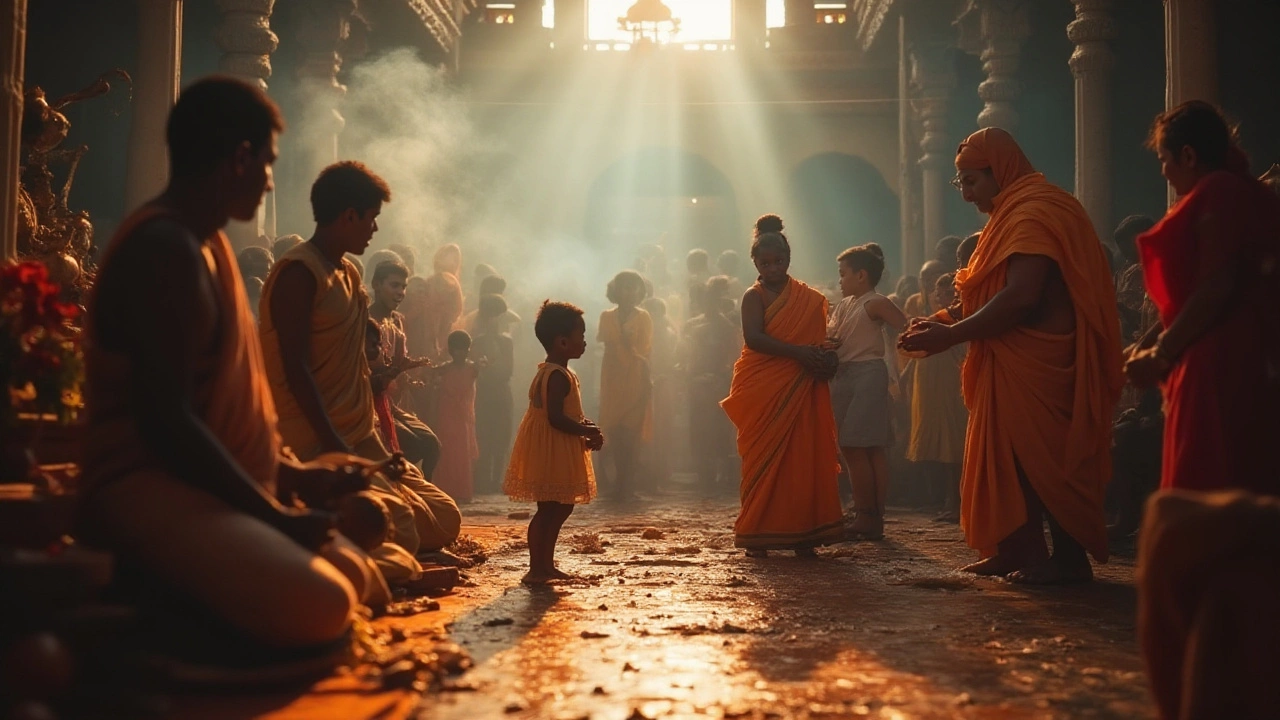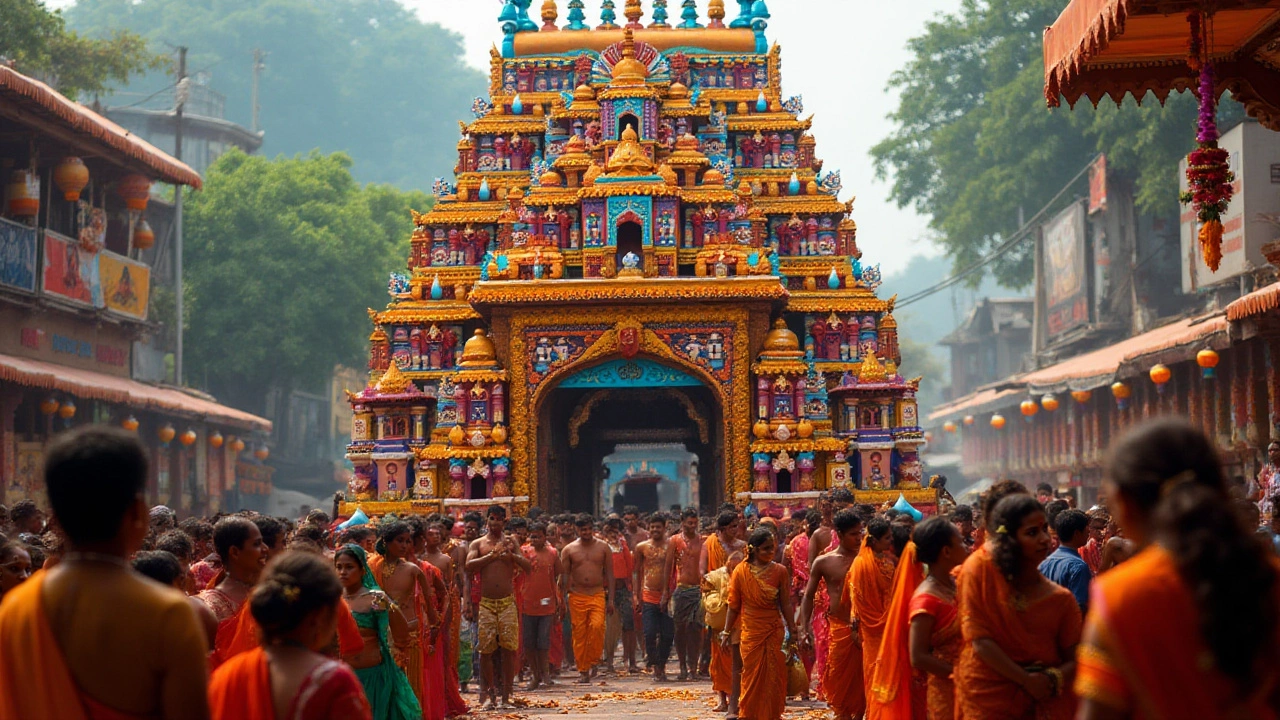Stepping into a Hindu temple is like entering a rich tapestry of profound faith and historical resonance, where every corner exudes spirituality. Such places are not mere tourist spots; they are sacred sites that embody centuries-old traditions and communal devotion. For those journeying through India, visiting these temples can be a remarkable experience if approached with an open heart and respectful demeanor.
Understanding the dos and don'ts before you arrive can make all the difference in not only enhancing your personal experience but also in showing respect to those worshipping around you. It's about blending genuine curiosity with mindful reverence. These are spaces woven deeply into the fabric of local life, each with its unique customs and ceremonies that guide the rhythms of daily worship.
- Understanding the Cultural Significance
- Dressing Appropriately
- Temple Etiquette and Behavior
- Understanding Rituals and Practices
- Interacting with Locals
- Contributing Respectfully
Understanding the Cultural Significance
The very essence of Hindu temples in India is steeped in layers of symbolism and spirituality that date back thousands of years. To understand this cultural significance is to gain insight into the heart of Hindu philosophy and lifestyle. These temples are not only architectural marvels but also the vibrant epicenters of social, cultural, and spiritual life.
At the core, temples in India serve as sacred spaces where the divine presence is intensely felt. They are constructed with meticulous attention to sacred geometry, embodying the cosmic connection between the earthly and the divine. Each part of the temple reflects a certain aspect of the universe understanding, from the gopuram or towering entrance, symbolizing the mountains, to the sanctum sanctorum representing the cave - a divine womb. This meticulous design illustrates not only architectural brilliance but also an intrinsic part of Hindu culture's emphasis on harmony with the cosmos.
Many temples were historically pivotal in shaping civilizations, marking the convergence of art, education, and community welfare. In ancient times, temples were much more than places of worship – they were centers of learning, music, and dance. The temple served as a living entity, nurturing and preserving the traditional arts and societal virtues. As Dr. R. Nagaswamy, an esteemed archaeologist and heritage scholar puts it,
'Temples were the heart of art and culture, spreading over centuries, teaching lessons of harmony and cosmic order.'The architecture itself stands as a testament to the artisans' devotion and unsurpassed skills, with sculptures and carvings that narrate tales from Hindu mythology.
In addition to their architectural beauty, temples echo with the chants and rituals that form the daily pulse of spiritual life. These rituals, often witnessed by visitors, are not perfunctory; they reflect a deep, evolving connection between humankind and the divine. Festivals and ceremonies conducted within these sacred walls are lively manifestations of age-old traditions and beliefs. They are colorful, vibrant affairs, drawing people from different parts of the community and offering a glimpse into the communal aspects of Hindu worship.
Understanding this cultural context not only enriches the travel experience but also cultivates respect and appreciation for the belief systems that thrive in these hallowed spaces. By immersing in the spiritual rhythm of temple life, visitors can witness firsthand how devotion transcends hundreds of years, still resonating with present-day practices and beliefs. Being mindful of the profound cultural significance underscores the respectful approach needed when stepping into these age-old sanctuaries.
Dressing Appropriately
When visiting Hindu temples in India, attire is not just a matter of fashion; it reflects deep-seated respect for tradition and spirituality. This isn’t merely about adhering to a dress code, but about understanding a cultural expectation that signifies reverence. Clothing that respects the sanctity of these spaces can vary slightly from temple to temple, but some common themes emerge. Both men and women are encouraged to wear outfits that cover the shoulders, arms, and legs. For men, traditional garments such as the dhoti or kurta are appreciated, while women often choose saris, salwar kameez, or long skirts paired with modest tops. It's vital to refrain from wearing tight or revealing clothing, ensuring that journeyers into these spiritual places do so with an understanding that their physical presentation is an extension of honor and humility.
Footwear is usually left outside, speaking to the idea of entering a sacred zone with a mind free of worldly distractions. This act of removing shoes isn’t simply about cleanliness, but an act of leaving behind the exterior world and stepping into a realm of peace and divinity. It’s quite common to find rows of shoes neatly lined up outside temple entrances, an age-old tradition that fosters a sense of equality among all visitors regardless of stature. Having a pair of easily removable shoes can ease the practice of entering and exiting during diverse temple activities.
"Dressing with modesty and respect allows the culture and spiritual experience of a temple visit to unfold more freely," says Priya Kaul, a cultural historian with expertise in Indian traditions. Her words emphasize how attire can bridge the gap between cultures and be an opening towards deeper understanding.
Color can play a significant role in temple visits, too, although not as strictly as clothing style. Bright and cheerful colors are often preferred, symbolizing vibrancy and potential. Whites are typically reserved for mourning, so they are best avoided, unless specifically required by particular temple customs. It's an eye-opening experience to see how locals use attire to express worship and reverence within these timeless walls. Dressing not only connects visitors to the current rituals but also nods to generations who have walked these paths before.
Lastly, it’s wise to be prepared for variations, as some temples might have specific rules in place due to regional practices or the deity they house. It's always a good idea to check ahead or inquire upon arrival. But most importantly, dressing appropriately when visiting these profound places allows for a sense of connection and participation in something far larger than oneself. This thoughtful approach to clothing resonates deeply within the temples' tranquil walls, creating a ripple of respectful engagement amidst the clamor of discovery.

Temple Etiquette and Behavior
Visiting a Hindu temple in India requires an understanding of specific temple visit guide customs to ensure a respectful and fulfilling experience. As you approach a temple, you'll often find intricately carved gopurams, or tower gates, marking your entry into a sacred space. The reverence for these sites is palpable, and it's vital to act in a way that aligns with the religious sanctity. Firstly, always remove your shoes before entering the temple premises. This gesture is a universal sign of respect and humility across many cultures, but especially in Hinduism, where cleanliness and the separation of the sacred from the mundane are emphasized. Many temples provide shoe storage areas for this purpose, so be sure to utilize these facilities.
Silence and decorum are highly valued within these hallowed halls. Upon entering, you'll often notice a hushed atmosphere punctuated only by the soft sounds of chant or bells. Speaking loudly or making disruptive noises is generally frowned upon. Consider pairing your visit with the quieter hours of the day, avoiding festival times if your intent is to meditate or reflect. It's also important to refrain from touching the idols or any of the sacred objects. Offerings are a common practice, yet it’s crucial to observe how locals present theirs before following suit. Different temples might have distinct practices regarding offerings, so staying observant and asking if unsure can prevent any unintentional disrespect.
"To worship in a Hindu temple is to understand the relationship of divinity and humanity," says art historian Diana Eck. "It's through ritual and disciplined behavior that one traverses the path of the spiritual with unequivocal reverence."
Photography can be another sensitive area within temple premises. Some temples strictly prohibit it, primarily to maintain the sanctity and protect the divine images from becoming commercialized. Others may allow photography in designated areas for a small fee. Always seek guidance from signage or temple authorities before taking any photographs. Be mindful also of the personal space of fellow visitors and worshippers. Recognize that temples are, after all, places of personal refuge and meditation, and thus deserve our respect in every respect. Finally, it is courteous to leave a small donation as a token of appreciation for the temple's upkeep and continual offering of spiritual solace to travelers and locals alike.
Understanding Rituals and Practices
Immersing yourself in the rituals of a Hindu temple offers a closer glimpse into practices that have withstood the test of time. Rituals vary significantly across different temples and regions, yet each serves to establish a divine connection, transcending the everyday and inviting contemplation. From simple offerings to grandiose ceremonies, these practices offer pathways to understand the spiritual ethos of Hinduism. Observing or participating with respect can transform a visit into a meaningful encounter.
As you wander through a temple, you'll often witness a plethora of sacred rituals, from the aarti—a mesmerizing light ceremony that involves the use of fire—to abhishekam, a sacred bathing ceremony using milk, yogurt, ghee, honey, sugar, and water to honor the deity. These rituals are not mere performances; they are acts filled with symbolic meaning. For instance, the light of the aarti is not just physical illumination but a symbolic gesture of dispelling darkness, both literal and metaphorical. Understanding these profound intents can enrich your experience multifold.
It’s crucial to approach these rituals with a level of sacred respect. Many rituals may involve rhythmic chanting of mantras in Sanskrit, an ancient language that resonates with historical and spiritual significance. It's a language that has been an integral vehicle for conveying spiritual ideas for over 3,500 years. When hearing these chants, one might notice how they echo through the temple, resonating with the architecture and lending a tranquil ambience. Joining in silently with openness can offer a humbling sense of unity, even for those who do not comprehend the language.
The practice of pradakshina, or walking in a clockwise direction around the deity or the temple, symbolizes the idea of keeping the divine at the center of one's thoughts. This act of circling sanctifies the space, balancing cosmic energies and reaffirming the faith of devotees. It's not just a physical movement but a meditative process, often undertaken in reverence and focused contemplation. A visitor might see it mirrored in the graceful movements of local worshippers and is welcome to join respectfully if the ritual context permits.
Listening to locals or a temple guide can offer deeper insights and personal anecdotes that books cannot convey. A quote from Radhika Shah, a temple historian, captures this beautifully:
"In every clink of the bell and every step taken within these walls, there lies a story told not just in words but in rituals that dance fluidly through time."Such insights lend depth to the rich tapestry of practices you're witnessing and participating in. It's a warm reminder that rituals are stories as much as they are acts of worship.

Interacting with Locals
Engaging with the locals during a visit to a Hindu temple is a powerful way to gain deeper insights into the cultural nuances and religious practices intrinsic to the localization. Connecting with the community brings not just historical anecdotes to life, but provides tangible context to the vibrant, intricate rituals you observe. Whether you find yourself amidst a colorful festival or a tranquil daily puja, talking to the locals can enhance your understanding of what's unfolding before your eyes. It's beneficial to approach these interactions with openness and genuine curiosity, as many locals are proud of their heritage and eager to share stories or explain the significance of temple traditions to visitors.
A thoughtful way to start a conversation is by inquiring about the history of the temple. Most locals are well-versed in the legends and historical facts surrounding their sacred sites. If you express interest in how the Hindu culture has shaped their lives, you might unlock narratives of personal devotion that enrich your visit. Sometimes, showing respect through a simple greeting in the local dialect can open doors to warm interactions. For instance, a respectful "Namaste" can break the ice and offer a familiar tone of politeness and sincerity.
Part of respectful interaction involves observing non-verbal cues. Temples are places of meditation and introspection, and you'll notice that many worshippers may engage in silent reflection or chant softly in prayer. Awareness of these subtle nuances allows you to adjust your own behavior accordingly, ensuring you don't inadvertently disrupt the solemnity of the environment. If you're unsure, it’s always okay to quietly ask someone nearby if it's appropriate to join in or if observing from a distance is preferable.
The Times of India once noted, "Temples are living testimonies of India's religious spirit and an intrinsic part of its cultural fabric." This holds true as you watch elders narrate tales of devotion to groups of spellbound children or families gather during auspicious ceremonies to offer prayers together. Such experiences highlight the communal aspect of temple life, where rituals and routines form the backbone of social bonds as much as they do religious ones.
Occasionally, language might seem like a barrier, but gestures and facial expressions convey universal meanings of respect and gratitude. Many travelers find that a smile coupled with patience is often all it takes to bridge the divide. Remember, while it's tempting to photograph picturesque moments or the elaborate decor, always ask for permission first, especially if locals are present in the scene. Respecting personal and sacred spaces reinforces a smoother rapport.
For a more structured interaction, consider joining a guided tour led by locals, which often supports the community financially. These tours not only offer translations and detailed explanations but also provide a platform for cultural exchange where you can ask questions and receive insights in return. As you step back into the world outside, these meaningful exchanges won't just leave you with photos to treasure, but memories and a deeper appreciation for the vibrant tapestry of Indian temple life.
Contributing Respectfully
Visiting a Hindu temple is not just about admiring the intricate architecture or participating in the rituals; it's also about giving back, contributing in a manner that aligns with the temple's needs and traditions. Contribution can come in various forms—be it through donations, volunteer work, or respectful engagement with the spiritual community. It's essential to understand that each temple has its own set of guidelines about how visitors can contribute. These practices are deeply rooted in sustaining both the physical structures and the spiritual essence of the temple environment, preserving it for future generations.
A simple monetary donation is one of the most common ways visitors can contribute. Many temples have designated areas where you can offer money, and the funds typically go towards temple maintenance, the salaries of priests, and various temple activities. The act of donating is considered a karmic gesture, reflecting the belief that what you give to a place of worship will return to you in many blessings. Some temples might also display lists of ongoing projects or needs, and you can choose to allocate your donation accordingly based on where it is most needed.
Engaging in volunteer work is another powerful way to contribute. Many temples welcome help with daily operations, whether it's assisting with cleaning, helping in the kitchen, or participating in temple events as support staff. Being a volunteer not only aids the temple but also provides a sense of fulfillment and closer connection to the community. When volunteering, it is crucial to adhere to the procedures and follow the guidance of temple coordinators to ensure that your contributions are meaningful and fitting.
Occasionally, temples organize special gatherings or 'sevas'—ritual services where volunteers can play an active role in the ceremonies. This can range from participating in cleaning sacred icons to helping prepare and distribute 'prasadam', the blessed offerings given to devotees. Temple authorities generally announce such opportunities, and these events allow for a deeper involvement, creating a unique blend of service and spirituality.
Giving back to the temple can also mean participating responsibly in temple festivities and educational programs. Engaging in cultural and spiritual events hosted by the temple enriches the experience and helps promote the practices that give life to Hindu culture. Each event represents an opportunity to learn and grow while supporting the temple's mission to educate and spread the rich religious and cultural narratives.
"Giving is not just about making a donation. It is about making a difference." - Kathy Calvin, CEO of the United Nations FoundationAnother way to contribute is through non-monetary gifts, such as donating food or supplies. These are particularly useful when the temple hosts large gatherings or special festivals and require more resources to accommodate attendees. Be sure to check with temple officials beforehand to ensure the appropriateness of your gifts. Finally, spreading awareness about the temple, its history, and its needs among your network can contribute to a broader reach and impact.
For international or long-term travelers, joining temple membership programs or becoming a recurring donor can offer continued support. These memberships often come with detailed information about the temple’s requirements and also provide news updates on how your contributions are being utilized to make a difference within the community. Remaining engaged with the temple's initiatives, even from afar, fosters a lasting connection to this sacred space.
